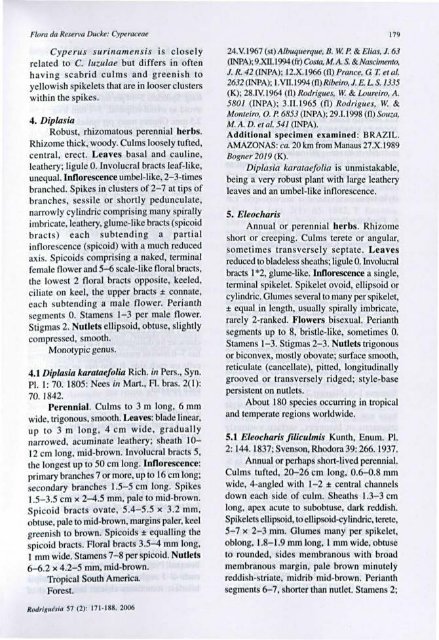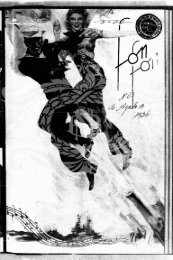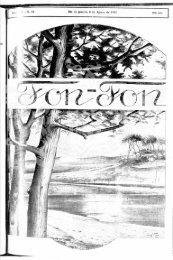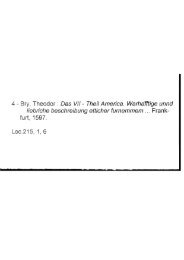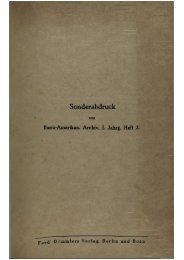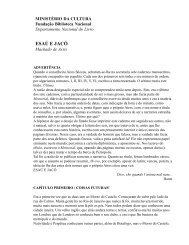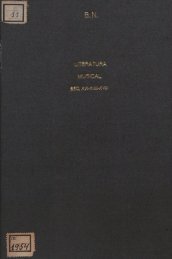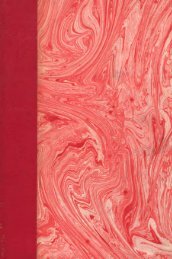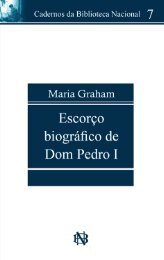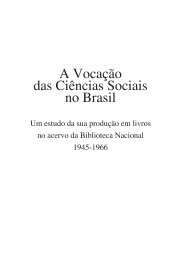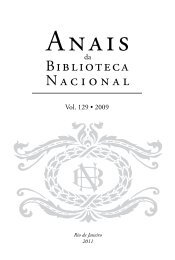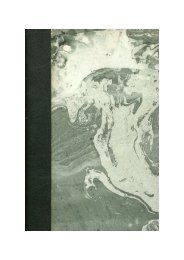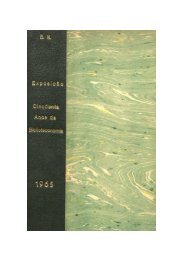RODRIGUESIA Revista do Jardim Botânico do Rio de Janeiro
RODRIGUESIA Revista do Jardim Botânico do Rio de Janeiro
RODRIGUESIA Revista do Jardim Botânico do Rio de Janeiro
You also want an ePaper? Increase the reach of your titles
YUMPU automatically turns print PDFs into web optimized ePapers that Google loves.
Flora da Reserva Ducke: Cyperaceae 179<br />
Cyperus surinamensis is closely<br />
related to C. luzulae but differs in often<br />
having scabrid culms and greenish to<br />
yellowish spikelets that are in looser clusters<br />
within the spikes.<br />
4. Diplasia<br />
Robust, rhizomatous perennial herbs.<br />
Rhizome thick, woody. Culms loosely tufted,<br />
central, erect. Leaves basal and cauline,<br />
leathery; ligule 0. Involucral bracts leaf-like,<br />
unequal. Inflorescence umbel-like, 2-3-times<br />
branched. Spikes in clusters of 2-7 at tips of<br />
branches, sessile or shortly pedunculate,<br />
narrowly cylindric comprising many spirally<br />
imbricate, leathery, glume-like bracts (spicoid<br />
bracts) each subtending a partial<br />
inflorescence (spicoid) with a much reduced<br />
axis. Spicoids comprising a naked, terminal<br />
female llower and 5-6 scale-like floral bracts,<br />
the lowest 2 floral bracts opposite, keeled,<br />
ciliate on keel, the upper bracts ± connate,<br />
each subtending a male flower. Perianth<br />
segmenta 0. Stamens 1-3 per male flower.<br />
Stigmas 2. Nutlcts ellipsoid, obtuse, slightly<br />
compressed, smooth.<br />
Monotypic genus.<br />
4.1 Diplasia karataefolia Rich. in Pers., Syn.<br />
PI. 1: 70. 1805: Nees in Mart., Fl. bras. 2(1):<br />
70. 1842.<br />
Perennial. Culms to 3 m long, 6 mm<br />
wi<strong>de</strong>, trigonous, smooth. Leaves: bla<strong>de</strong> linear,<br />
up to 3 m long, 4 cm wi<strong>de</strong>, gradually<br />
narrowed, acuminate leathery; sheath 10-<br />
12 cm long, mid-brown. Involucral bracts 5,<br />
the longest up to 50 cm long. Inflorescence:<br />
primary branches 7 or more, up to 16 cm long;<br />
secondary branches 1.5-5 cm long. Spikes<br />
1.5-3.5 cm x 2-4.5 mm, pale to mid-brown.<br />
Spicoid bracts ovate, 5.4-5.5 x 3.2 mm,<br />
obtuse, pale to mid-brown, margins paler, keel<br />
greenish to brown. Spicoids ± equailing the<br />
spicoid bracts. Floral bracts 3.5-4 mm long,<br />
1 mm wi<strong>de</strong>. Stamens 7-8 per spicoid. Nutlets<br />
6-6.2 x 4.2-5 mm, mid-brown.<br />
Tropical South America.<br />
Forest.<br />
R.nlrixuésia 57 (2): 171-188. 2006<br />
24.V.1967 (s\) Albuquerque. B.W.P.&. Elias, J. 63<br />
(INPA); 9.XII. 1994 (fr) Costa, M. A. S. & Nascimento,<br />
J. R. 42 (INPA); 12.X.1966 (ti) Prance, G T. et ai.<br />
2632 (INPA); 1 .VII. 1994 (fl) Ribeiro, J. E. L. S. 1335<br />
(K); 28.IV. 1964 (fl) Rodrigues, W. & Loureiro, A.<br />
5801 (INPA); 3.II.1965 (fl) Rodrigues, W. &<br />
Monteiro, O. P. 6853 (INPA); 29.1.1998 (fl) Souza,<br />
M. A. D. et ai. 541 (INPA).<br />
Additional specimen examined: BRAZIL.<br />
AMAZONAS: ca. 20 km from Manaus 27.X.1989<br />
Bogner2019(K).<br />
Diplasia karataefolia is unmistakable,<br />
being a very robust plant with large leathery<br />
leaves and an umbel-like inflorescence.<br />
5. Eleocharis<br />
Annual or perennial herbs. Rhizome<br />
short or creeping. Culms terete or angular,<br />
sometimes transversely septate. Leaves<br />
reduced to bla<strong>de</strong>less sheaths; ligule 0. Involucral<br />
bracts 1 *2, glume-like. Inflorescence a single,<br />
terminal spikelet. Spikelet ovoid, ellipsoid or<br />
cylindric. Glumes several to many per spikelet,<br />
± equal in length, usually spirally imbricate,<br />
rarcly 2-ranked. Flowers bisexual. Perianth<br />
segments up to 8, bristle-like, sometimes 0.<br />
Stamens 1-3. Stigmas 2-3. Nutlets trigonous<br />
or biconvex, mostly obovate; surface smooth,<br />
reticulate (cancellate), pitted, longitudinally<br />
grooved or transversely ridged; style-base<br />
persistent on nutlets.<br />
About 180 species oceurring in tropical<br />
and temperate regions worldwi<strong>de</strong>.<br />
5.1 Eleocharis filiculmis Kunth, Enum. PI.<br />
2:144.1837;Svenson,Rho<strong>do</strong>ra39:266.1937.<br />
Animal or pcrhaps short-lived perennial.<br />
Culms tufted, 20-26 cm long, 0.6-0.8 mm<br />
wi<strong>de</strong>, 4-angled with 1-2 ± central channels<br />
<strong>do</strong>wn each si<strong>de</strong> of culm. Sheaths 1.3-3 cm<br />
long, apex acute to subobtuse, dark reddish.<br />
Spikelets ellipsoid, to ellipsoid-cylindric, terete,<br />
5-7 x 2-3 mm. Glumes many per spikelet,<br />
oblong, 1.8-1.9 mm long, I mm wi<strong>de</strong>, obtuse<br />
to roun<strong>de</strong>d, si<strong>de</strong>s membranous with broad<br />
membranous margin, pale brown minutcly<br />
reddish-striate, midrib mid-brown. Perianth<br />
segments 6-7, shorter than nutlet. Stamens 2;


